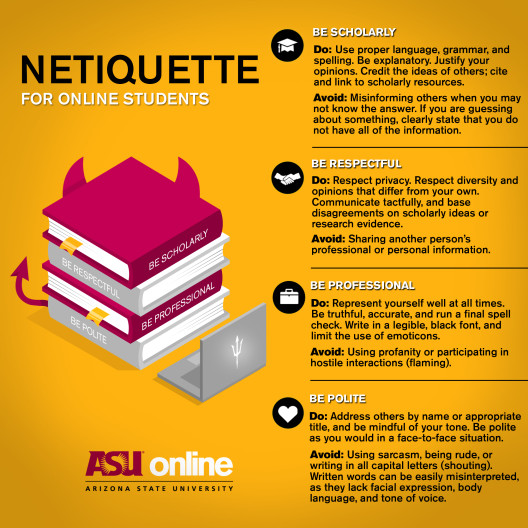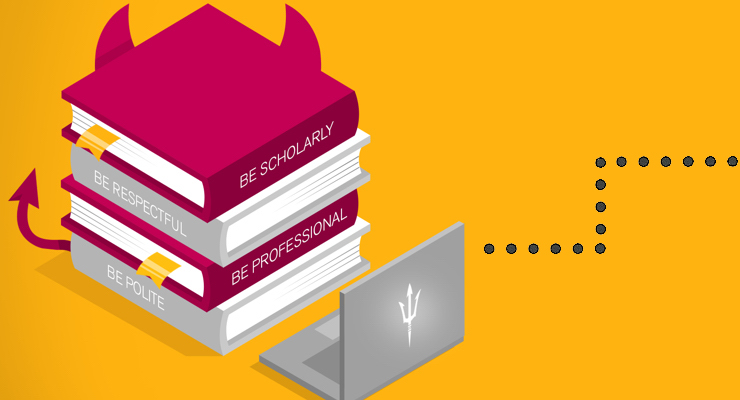Are You Teaching Good Netiquette?
Defining appropriate behavior for interactions among online students helps to create a positive and respectful learning environment.
The aim of education is the intellectual, personal, social, and ethical development of the individual. The educational process is ideally conducted in an environment that encourages reasoned discourse, intellectual honesty, openness to constructive change, and respect for the rights of all individuals. –Student Code of Conduct

Image Credit: Stephen Valdivia. Click here to download the above image as a PDF.
Incorporating Netiquette Guidelines into Online Courses
Online etiquette or “netiquette” is an unofficial social code concerned with “good” behavior for communicating online. Consider writing netiquette guidelines that reflect your own philosophy and teaching style, or link to an existing resource. You may post the graphic above in your course; alternatively, click here to download another version of this graphic from our Succeed Online student website (Image credit: Ron Carranza.) Below are a few strategies for incorporating netiquette guidelines into your course:
- Include a netiquette statement in the course syllabus.1 Refer to the Student Code of Conduct, and consider placing this alongside Academic Integrity.
- Incorporate netiquette standards into grading rubrics. For example, criteria for grading discussion posts may include overall professionalism.
- Facilitate a discussion among students early in the course in which they define “good” netiquette. Wrap up by clarifying your expectations for their interactions when participating in discussion forums.
Common Rules of Netiquette
Reviewing netiquette guidelines written by others is a helpful way to determine appropriate standards for your own students. Many common rules fall under four categories:
- Be scholarly. Students should use proper language, grammar, and spelling. They should be explanatory, justify their opinions, and credit the ideas of others by citing or linking to scholarly resources. Students should avoid misinforming others when they may not know the answer to something. When students are discussing something they are unsure about or supplying a guess, they should clearly state that.
- Be respectful. The privacy of others must be respected; students should avoid sharing personal or professional information about classmates. Students should respect diversity and opinions that differ from their own. Communication should be tactful, with disagreements based on scholarly ideas or research evidence.
- Be professional. Everyone should strive to look their best online.2 Truthfulness, accuracy, and running a final spell check are appropriate expectations for university students. Writing in a legible font and limiting the use of emoticons is considered professional behavior. Profanity and participation in hostile interactions, known as flaming, is unprofessional as well as disruptive.
- Be polite. Students should be addressing professors and instructors by the appropriate title or requested name. Students should also address each other by name and be mindful of their written tone. Students should interact online politely, just as they would be expected to do in a physical classroom environment. Sarcasm rudeness, and writing in all capital letters (shouting) should be avoided.
Discussion Board Netiquette
Common discussion board rules, in addition to the use of proper spelling and grammar, are:
- Read all other comments before posting. Students should contribute by adding to the discussion, not by repeating in their own words what others have already posted. In addition, other students may have posted questions about the course or an assignment that have already been answered within the discussion board.3-5
- Be clear and stay on topic. Be clear about what you are saying so that it is not misunderstood. Read your words aloud before posting to test the clarity of your message.3-5
- Be mindful of your tone. The tone of messages in an academic environment should be polite and display respect for others. The use of sarcasm, profanity, and ALL CAPS (shouting) should be avoided.3-6
- Be credible. Do not mislead other students by providing information that might not be accurate. If your response is a guess, state that clearly. Be sure to give credit where it is due by citing sources, providing links, or crediting the ideas of other classmates.3-5
- Respect diversity. Online courses bring students together from all over the world. Recognize that others may have different cultural backgrounds and skill levels with writing in the English language. Treat others with respect, regardless of race, gender, religious beliefs, and sexual orientation. Additionally, be respectful when opinions differ from your own; disagree in a polite manner. 3-5
For More Information
The resources referenced in this article may be helpful in the development of your own netiquette guidelines. More information about Arizona State University’s required behavior standards can be obtained from the Student Code of Conduct and Student Disciplinary Procedures, the Computer, Internet, and Electronic Communications policy, and the Office of Student Rights & Responsibilities.
References
- Mintu-Wimsatt A. Netiquette: Make it part of your syllabus. Journal of Online Learning and Teaching. 2010;6(1):264. http://jolt.merlot.org/vol6no1/mintu-wimsatt_0310.pdf Accessed March 23, 2016.
- Shea V. The Core Rules of Netiquette. Online ed. Albion Books; 1994. http://www.albion.com/netiquette/corerules.html Accessed April 8, 2016.
- Connor P. Netiquette: Ground rules for online discussions. http://teaching.colostate.edu/tips/tip.cfm?tipid=128 Accessed March 23, 2016.
- Pappas C. Netiquette tips for online discussions. http://elearningindustry.com/10-netiquette-tips-online-discussions Accessed March 23, 2016.
- Touro College. 15 rules of netiquette for online discussion boards [INFOGRAPHIC]. http://blogs.onlineeducation.touro.edu/15-rules-netiquette-online-discussion-boards Updated 2014. Accessed March 23, 2016.
- Berk R. Top 12 be-attitudes of netiquette for academicians. The Journal of Faculty Development. 2011;25(3):45. http://www.ronberk.com/articles/2011_attitudes.pdf Accessed April 7, 2016.



